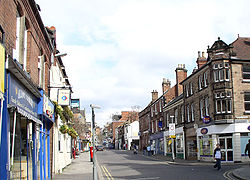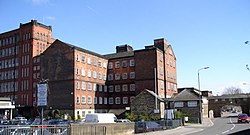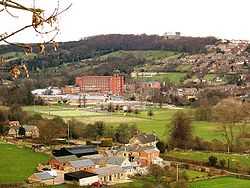Belper
| Belper | |
| Derbyshire | |
|---|---|
 King Street, Belper | |
| Location | |
| Grid reference: | SK351476 |
| Location: | 53°1’44"N, 1°28’30"W |
| Data | |
| Population: | 20,548 |
| Post town: | Belper |
| Postcode: | DE56 |
| Dialling code: | 01773 |
| Local Government | |
| Council: | Amber Valley |
| Parliamentary constituency: |
Mid Derbyshire |
Belper is a town in Derbyshire, found eight miles north of Derby in the valley of the River Derwent.
The A6 from Derby is the major through-road of the town and runs parallel to the River Derwent to the west. The town is also on the Midland Main Line with its own station. Regular trains run between Derby and Matlock on the Derwent Valley Line.
Churches
The parish church is St Peter's, a prominent landmark in the town, was built in 1824 to replace the smaller 13th-century St John's Chapel which is now used as a town council and heritage chamber. A second Church of England church, Christ Church, was built in 1850. A local saying calls St Peter's "the low church in the high place" and Christ Church "the high church in the low place" based on their different liturgical traditions.
The oldest church still used for its original purpose is the Belper Unitarian Church, built in 1788. The present Methodist Church was opened on 28 June 1807 and was originally built to hold 1,400 worshippers.
- Church of England:
- St Peter's
- Christ Church
- Baptist
- Belper Community Church which meets at the Strutt Centre
- Methodist
- (Two churches)
- Roman Catholic

History
At the time of the Norman invasion, Belper was part of the land centred on Duffield held by the family of Henry de Ferrers. The Domesday Book records a manor of "Bradley" which is thought to have stood in an area of town now known as the Coppice. At that time it was probably within the Forest of East Derbyshire which covered the whole of the county east of the Derwent. The manor was possibly appropriated by William de Ferrers, 4th Earl of Derby at some time after it was disafforested in 1225 and became part of Duffield Frith.[1]
The town's name is thought to be a corruption of Beaurepaire - meaning beautiful retreat - the name given to a hunting lodge, the first record of which being in a charter of 1231. This would have been the property of Edmund Crouchback, 1st Earl of Lancaster who died in 1296, the record of his estate mentioning "a capital mansion". The chapel built at that time still exists. Originally consecrated in 1250 as the Chapel of St Thomas, it was rededicated to St John during the reign of King Henry VIII. St John's Chapel is still in use today and is thought to be the oldest building still standing in Belper.



The coal deposits of Derbyshire are frequently associated with ironstone within the clay substrate. Initially obtained from surface workings, it would later have been mined in shallow bell pits. It is thought that this was important for the de Ferrers family, who were ironmasters in Normandy.[2] By the reign Henry VIII, Belper had grown to a substantial size. It is recorded that in 1609 fifty-one people died of plague.[3] However, in a Parliamentary Commissioners' report of 1650 regarding Duffield and its chapelries, Belper is described as "a hamlet appertaining to Duffield".[4]
From at least the 13th century there were forges in the Belper and Duffield areas and iron-working became a major source of income, particularly nail making. By the end of the eighteenth-century there were around 500 workshops in the town supplying nails to the newly-built textile mills. The workshops were eventually superseded by machinery during the nineteenth-century. Some of the nail-makers houses are still in existence and form part of local tours of the town.
The industrialist Jedediah Strutt, a partner of Richard Arkwright, built a water-powered cotton mill in Belper in the late eighteenth-century: the second in the world at the time. With the expansion of the textile industry Belper became one of the first mill towns. In 1784 Strutt built the North Mill and, across the road, the West Mill. In 1803 the North Mill was burnt down and replaced by a new structure designed to be fireproof. Further extensions followed, culminating in the East Mill in 1913 - a present-day Belper landmark. Although no longer used to manufacture textiles the mill still derives electricity from the river, using turbine-driven generators.
Strutt had previously patented his "Derby Rib" for stockings, and the plentiful supply of cotton encouraged the trade of framework knitting which had been carried on in the town and surrounding villages since the middle of the previous century. Mechanisation arrived about 1850, but by that time the fashion for stockings for men was disappearing. However elaborately patterned stockings, for ladies especially, were coming into vogue, and the output of the Belper "cheveners" was much in demand.
The construction of the North Midland Railway in 1840 brought further prosperity. Belper was the first place in the United Kingdom to get gas lighting, at a works erected by the Strutts at Milford, Derbyshire|Milford. Demand was such that in 1850, the Belper Gas and Coke Company was formed, with a works in the present Goods Road. Electricity followed in 1922 from the Derby and Nottingham Electrical Power Company's works at Spondon. The first telephones came in 1895 from the National Telephone Company. The end of the century also brought the motor car, CH218, owned by Mr. James Bakewell of The Elms being possibly the first.
Belper remained a textile and hosiery centre into the 20th century. Meanwhile, other companies were developing: iron founding led to the Park Foundry becoming a leader in the solid-fuel central-heating market; Adshead and Ratcliffe had developed Arbolite putty for iron-framed windows; Dalton and Company, which had been producing lubricating oils, developed ways of recovering used engine oil proving useful during the Second World War. In 1938, A.B.Williamson had developed a substance for conditioning silk stockings; the introduction of nylon stockings after the Second World War seemed to make it redundant, but mechanics and fitters had discovered its usefulness in cleaning hands and it is still marketed by Deb Group as Swarfega.
Economy

Belper's economy was traditionally reliant on manufacturing industry and numerous goods were made in the town. Cotton spinning and textile production were major employers virtually for much of the nineteenth- and early twentieth-centuries. The large East Mill and the smaller North Mill are now all that remain of the industry and are preserved as part of the Derwent Valley Mills world heritage site. After the Second World War, J. W. Thornton, the chocolate maker, moved into the town from Sheffield, which helped to alleviate the employment problems arising from the contraction of the earlier industries. In recent years, the company completed a move to a new site a few miles away in Swanwick, Derbyshire|Swanwick. Today, the main employment sectors are retail and services although some manufacturing industry remains. The main shopping area is centred around King Street. The town has three supermarkets.
Sport
- Football: Belper Town FC play their home games at Christchurch Meadow.[5] They are nicknamed The Nailers as a reference to the historical nail manufacturing industry in the town.
Poetry Trail
In 2009, members from two of the town's poetry groups completed a poetry trail in memory of local poet Beth Fender, who died in 2002.[6] Beth's Poetry Trail consists of 20 poems situated in a variety of locations in the town, such as outside Belper Library. Poems by Emily Dickinson, Philip Larkin and Spike Milligan are included on the trail, as well as Beth's own poetry.
Outside links
- Belper Town Council
- Derwent Valley Mills
- Site specific to the North Mill
- BBC: Historical account of the Belper nailers
- Belper Historical Research Website
References
- ↑ Turbutt, G., (1999) A History of Derbyshire. Volume 2: Mediæval Derbyshire, Cardiff: Merton Priory Press
- ↑ projects/eastmidsfw/pdfs/26deras.pdf Dave Barrett, Derbyshire County Council, East Midlands Archaeological Research Framework: Resource Assessment of Mediæval Derbyshire
- ↑ 'Parishes: Doveridge - Duffield', Magna Britannia: volume 5: Derbyshire (1817), pp. 129-142. URL: http://www.british-history.ac.uk/report.aspx?compid=50727. Date Retrieved 27 August 2008.
- ↑ Bland, J., (1921) Old Duffield Village, Church, and Castle, With some Personal Reminiscences, Derby:Harpur and Son
- ↑ "Belper Town Football Club". http://www.belpertownfc.co.uk. Retrieved 10 September 2012.
- ↑ "Poetry trail celebrates ex-nurse's passion for words and love of life". Derby Telegraph. http://www.thisisderbyshire.co.uk/Poetry-trail-celebrates-ex-nurse-s-passion-words-love-life/story-11624610-detail/story.html. Retrieved 31 December 2012.
- Naylor, P. (Ed) (2000) An Illustrated History of Belper and its Environs Belper: M.G.Morris